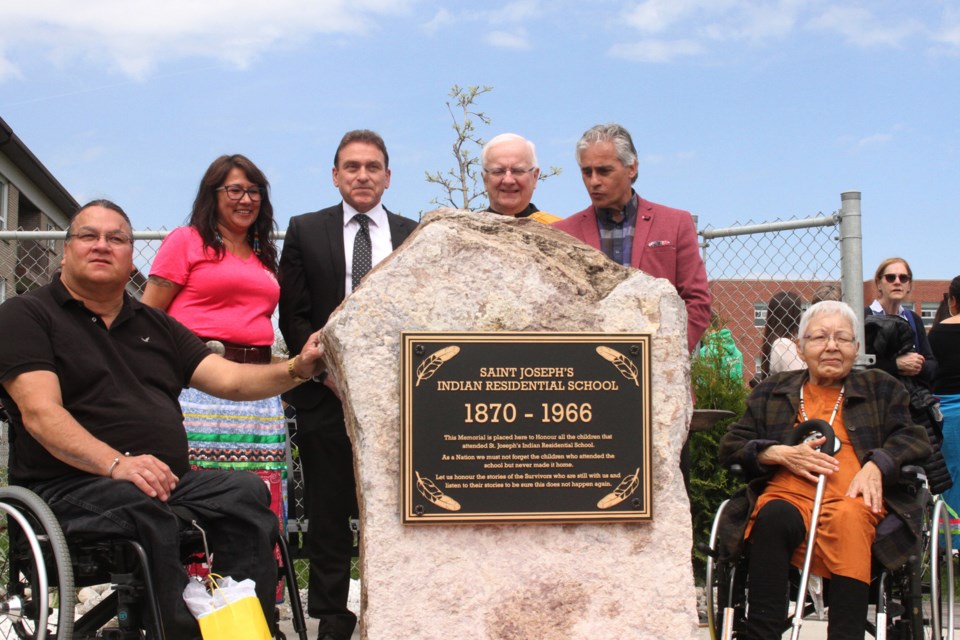THUNDER BAY - An evasive part of Thunder Bay’s history has been given ground to stand on, thanks to the efforts of a number of leaders in the local Indigenous community.
On Wednesday, the St. Joseph’s Indian Residential School memorial site was officially unveiled at Pope John Paul II Senior Elementary School, the very spot where it stood for more than 50 years before it was demolished in 1966.
Leadership from the city, Fort William First Nation, Nishnawbe Aski Nation, the Catholic Diocese of Thunder Bay, and the Catholic District School Board, all took to the podium to address the importance of the recognition of the former residential school.
None captivated the audience quite like Dolores Wawia, a former St. Joseph's student.
“When life gives you lemons, make lemonade,” she said to close her speech.
During her 20 minutes at the podium, Wawia told a wide range of stories she recounted while attending the school including physical punishment, daily protocol, and sexual education.
In the audience there were some tears, but mostly laughter.
“It’s a little heavy sometimes. The topic. For a lot of us it can swing both ways, it depends how you look at it,” she said. “All my life… I’ve learned laughter is good.”
Seven years in the making
For those involved with the process, the reveal of the monument was seven years in the making. On Wednesday, it was a long-overdue day of recognition.
“It’s amazing,” said Ann Magiskan, the city's Aboriginal liaison. “To have been part of the process right from the beginning, it feels wonderful. I've got goosebumps because I know I’m honoring the legacy of so many people that attended the schools. So many survivors that are still with us to this day, and all the children that never made it home.”
The design and placement of the monument was based on the information gathered from focus groups with First Nation elders, and survivors of residential schools.
Magiskan, whose mother attended a residential school, helped facilitate the vision of the monument over the course of seven years.
“I remember (the survivors) telling me ‘Ann, we’re a simple people. We don’t need anything extravagant.’ I wanted to honour my own mom’s story to make sure we had something that would stay here for a long time,” she said.
The marble stone is surrounded by a garden that includes the four medicines of the medicine wheel.
“Unity starts around the dinner table at home,” said NAN Deputy Grand Chief Derek Fox. “Take the time to understand, for your friends, or for your family, what our history is.”
Mayor Bill Mauro said during his remarks, “We need to listen… really listen to residential school survivors and tell our children. Pass down these stories.”
School's history
According to the Shingwauk project - a research and educational development program of Algoma University - St. Joseph’s was originally established in 1870 as the “Orphan Asylum of Fort William,” and was referred to as the ‘orphanage’ for most of its existence.
During its first year, it only accepted Indigenous girls, but gradually accepted males and eventually turned into a boarding school.
It operated on a half-day system where children attended school for part of the day and performed household tasks during the remainder of the day.
According to Tanya Talaga’s Seven Fallen Feathers, six children died at the school while another 16 are unaccounted for.
In 1906, the school was moved from Fort William First Nation to the corner of Arthur and Franklin Street after a portion of the First Nation was expropriated by the Grand Trunk Pacific Railway.
“I used to stand when the railroad track went by every night, the (passengers) would all stare at us. We’d stare at them too. Us, we wanted to get away,” said Wawia, who came to the school in 1949.
Wawia was a professor at Lakehead for over 40 years following her time at St. Joseph’s, and was appointed to the Order of Ontario in 2015 for her contribution to Indigenous teachers' education.
She got to share her insights throughout her career, “I would visit all the schools and tell them not all (Indigenous) live in teepees, and ride horses, and build totem poles. That was the stereotype in those days. I’m happy with the way things are now looking at the school system.”
Despite retiring five years ago, she was given another opportunity to tell her residential school story to a group of over 250 students on Wednesday.
“We do a lot of storytelling and watching. That’s how (Indigenous) children learn, and that’s what I had to teach teachers all my life.”
